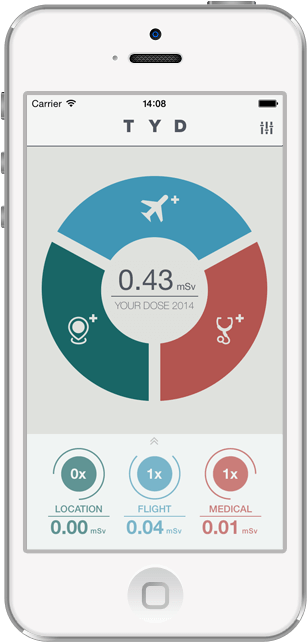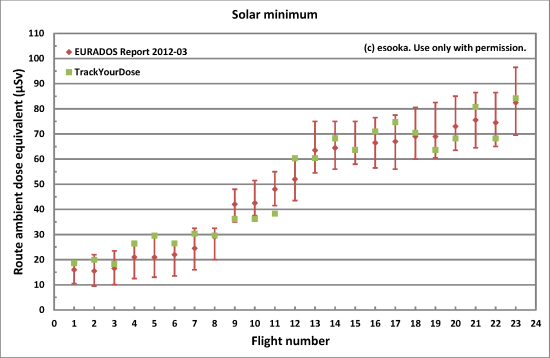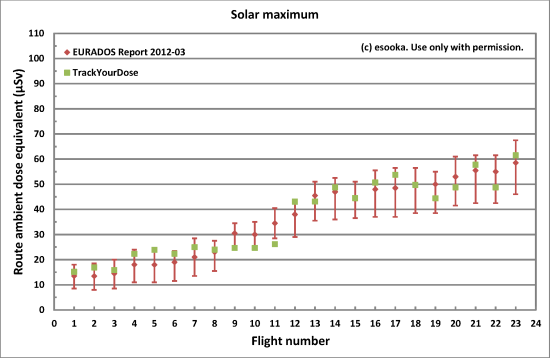

Received too much radiation?
Do you want to know your actual exposure to radiation? What is the radiation at your location? How much additional cosmic, ionizing and ambient radiation do you receive when you are getting x-rayed or on a certain flight?
TrackYourDose returns accurate values – calculated with scientifically sound data from the Physikalisch-Technische Bundesanstalt in Germany and the University Oulu, Finland.
With TrackYourDose you can keep a record of your personal radiation, and are able to gain an understanding of how medical examinations, changes in your location, and flights affect your personal effective radiation dose.
Radiation exposure at flight altitudes
TrackYourDose calculates the dose at flight altitudes with functions that have been published by the Physikalisch-Technische Bundesanstalt (PTB, national metrology institute) in Germany [1] and thus is based on measurements which can be traced back to primary standards of the PTB. The calculations are valid under normal conditions of the sun, this means that only the yearly change of the suns activity is considered. Therefore, TrackYourDose complies with currently authorised computer programs to calculate the exposure to radiation of flight personel in Germany. A comparison of all authorised programs with all exisiting programs has been conducted by EURADOS and is published in the EURADOS Report 2012-03 [2].
The exposure to radiation at flight altitudes mainly depends from the flight altitude and latitude and to a certain extend from the activity of the sun. The sun's activity terms the cyclic variation of the solar wind (11-year cycle) which causes a variation of the particle flux of cosmic rays in the atmosphere.
TrackYourDose utilizes the measurements of the neutron monitor of the University Oulu in Finland, which are given as countrate in "counts per minute". On 01/01/2015 the average countrate was 5848 counts/min. On days with high countrate this value can change up to approximately 40%. For instance, the countrate on the 15/09/2007 was 6693 counts/min.
The following graphs compare the calculated radiation dose of TrackYourDose with all published results from the EURADOS Report 2012-03 [2] for low solar activity ("solar minimum") and high solar activity ("solar maximum"). The calculated radiation exposure of TrackYourDose for the flight routes given in the report agree well with the range of variation of the report.


A typical radiation dose for a flight from Paris (Charles de Gaulle International Airport (CDG)) to San Francisco (San Francisco International Airport (SFO)) on the 01/01/2015 is approximately 0.049 mSv. This value increases for periods with increased solar activity such as on the 15/09/2007 to 0.064 mSv.
Sources:
[1] F. Wissmann, M. Reginatto, and T. Möller, “The ambient dose equivalent at flight altitudes: a fit to a large set of data using a Bayesian approach,” J. Radiol. Prot. 30 (3), 513–524 (2010).
[2] EURADOS Report 2012-03 (Comparison of Codes Assessing Radiation Exposure of Aircraft Crew due to Galactic Cosmic Radiation): http://www.eurados.org/en/Documents_Publications.
Natural exposure to radiation
The natural exposure to radiation results from cosmic radiation in the atmosphere, terrestrial radiation and the exposure to radiation due to food intake (ingestion) and breathing (inhalation). TrackYourDose calculates these components independently.
Cosmic radiation is generated in the upper layers of the atmosphere from extraterrestrial cosmic radiation. At flight altitudes the cosmic radiation consists of photons, electrons and positrons, myons and neutrons, and to a small extent of protons. The intensity almost exclusively depends on the barometric altitude. On ground level the radiation is about a factor of 100 smaller compared to typical flight altitudes. TrackYourDose calculates the radiation dose from cosmic radiation at your residence and short-term locations by using the GPS altitude of your phone. The cosmic radiation at sea level is approximately 0.3 mSv/a.
Since terrestrial radiation location-dependent TrackYourDose uses a database based on public available measurements. For a new location the closest measurement location will be determined from the phones location. If there are no close measurement locations available, TrackYourDose will calculate the average of all measurements in the surrounding area. Currently, the database contains terrestrial radiation data for Germany and the USA. For all other countries TrackYourDose uses a worldwide averaged value.
The terrestrial radiation data for Germany is measured in a dense measurement network from the Bundesamt für Strahlenschutz (Federal Office for Radiation Protection in Germany) with about 1800 measurement locations. TrackYourDose currently uses the published yearly averaged values from 2014 (TrackYourDose 1.2). The yearly dose from terrestrial radiation in Germany for all measurement locations is between 0.08 mSv/a and 1.22 mSv/a. The average dose for Germany is 0.48 mSv/a.
An daily updated map is available at http://odlinfo.bfs.de/. Please note that the data shown in the map is given in µSv/h (0.001 mSv/h) and consist of cosmic and terrestrial radiation.
The terrestrial radiation data for the USA are based on published data from the U.S. Geological Survey in the USGS Open-File Report 2005-1413 (Terrestrial Radioactivity and Gamma-ray Exposure in the United States and Canada). In this survey, the terrestrial radiation exposure was determined from airborne gamma-ray measurements. The USGS Report is available at http://pubs.usgs.gov/of/2005/1413/.
TrackYourDose has implemented average values for various countries for the radiation exposure from ingestion and inhalation, because only statistical average values are available. These values can vary due to personal lifestyle and environment.
Please note: TrackYourDose takes care the the natural radiation dose for your location is not accidentally counted twice. The radiation dose for your residence will not be calculated for periods of stays at another location.
Radiation exposure from medical examinations
Computer tomography (CT) and the classical X-ray examinations cause an exposure to radiation due to the ionizing X-ray radiation. The exposure level depends on the examined body part as well as the time and intensity of the radiation exposure. TrackYourDose uses published average values to determine the dose values [3-5]. Equipment type and manufacturer as well as individual and medical factors can cause a variation of the actually received dose.
Please note: The information in this application are for education purposes only and do not substitute for personal consultation, medical examination, or diagnosis through a physician.
Additional information can be found in the following publications:
[3] F. A. Mettler, W. Huda, T. T. Yoshizumi, and M. Mahesh, “Effective Doses in Radiology and Diagnostic Nuclear Medicine: A Catalog,” Radiology 248(1), 254–263 (2008). http://radiology.rsna.org/content/248/1/254.long.
[4] Health Physics Society, “Radiation Exposure from Medical Exams and Procedures,” January 2010. https://hps.org/documents/Medical_Exposures_Fact_Sheet.pdf.
[5] Bundesamt für Strahlenschutz (in German).
Radiation exposure from smoking
Additionally to the well-known side effects such as vascular constriction and chronic bronchitis smoking causes a radiation exposure of the lungs. The radiation exposure per cigarette depends on the smoking behaviour and composition of the tobacco.
TrackYourDose allows to set your personal smoking behaviour. When first starting the application, you will be asked to set your daily cigarette consume. In case your smoking behaviour changes, you can update your consume in the settings.
The radiation exposure per cigarette is included as constant value in TrackYourDose. According to this value, smoking of 20 cigarettes daily causes a yearly radiation dose of 0.3 mSv/a. This value was estimated as average value from various publication [6-12].
Sources:
[6] NCRP Report No. 095 - Radiation Exposure of the U.S. Population from Consumer Products and Miscellaneous Sources (Supersedes NCRP Report No. 56) (National Council on Radiation Protection and Measurements, Bethesda, Md., 1987-c1989).
[7] H. S. Karagueuzian, C. White, J. Sayre, and A. Norman, “Cigarette smoke radioactivity and lung cancer risk,” Nicotine & tobacco research : official journal of the Society for Research on Nicotine and Tobacco 14 (1), 79–90 (2012).
[8] C. Papastefanou, “Radiation dose from cigarette tobacco,” Radiation Protection Dosimetry 123 (1), 68–73 (2007).
[9] C. Papastefanou, “Radioactivity of Tobacco Leaves and Radiation Dose Induced from Smoking,” IJERPH 6 (2), 558–567 (2009).
[10] A. Sakoda, K. Fukao, A. Kawabe, T. Kataoka, K. Hanamoto, and K. Yamaoka, “Radioactivity of 210Pb in Japanese cigarettes and radiation dose from smoking inhalation,” Radiation Protection Dosimetry 150 (1), 109–113 (2012).
[11] B. Skwarzec, J. Ulatowski, D. I. Struminska, and A. Bory?o, “Inhalation of 210Po and 210Pb from cigarette smoking in Poland,” Journal of Environmental Radioactivity 57 (3), 221–230 (2001).
[12] Tahir, S N A and A. S. Alaamer, “PB-210 concentrations in cigarettes tobaccos and radiation doses to the smokers,” Radiation Protection Dosimetry 130 (3), 389–391 (2008).
Average exposure to radiation
The following graphic shows the average radiation exposure of an average person. The natural sources cause approximately 2.4 mSv/a of the yearly radiation dose. Additionally, medical examinations cause 0.6 mSv/a. This value may vary strongly between different countries.

Source: United Nations Scientific Committee on the Effects of Atomic Radiation, UNSCEAR 2008 Report: "Sources and effects of ionizing radiation".
Your exposure to radiation stems from natural and artificial sources. The natural background radiation consists of the terrestrial radiation and cosmic radiation from the universe. Whereas the composition of natural radioactive materials in the ground is the main source of the terrestrial radiation, the cosmic radiation basically depends on the elevation and geographic latitude. Besides the natural source several artificial source such as x-ray examinations or smoking cause an additional exposure to radiation. Flights increase the cosmic radiation for a short period of time due to the higher elevation.
What is (effective) dose?
The effective dose is a measure of the impact of radiation on the body. It accounts for the differences in effects of the different radiation types and allows them to be compared on a standard scale.
What is the meaning of mSv and mSv/a?
mSv = millisievert is a derived unit to measure the health effect of low levels of radiation on the human body.
Which factors influence the radiation during flights?
The radiation during flights depends mainly on the elevation and the geographic latitude. Furthermore, and to a lesser extent on the solar activity. To achieve an accurate estimation of the radiation exposure during flights this application uses a validated method developed by the PTB (the National Metrology Institute of Germany) and daily updated measurements of the solar activity from the university in Oulu (Finland).
Solar activity describes the changes of the solar wind which leads to changes of the particle flux of cosmic radiation into the atmosphere. This is measured for example by the neutron monitor operated by the University Oulu in Finland and is given as the neutron monitor count rate in counts per minute. The variation of the solar activity can influence the radiation exposure during flights by up to than 40 %.
Why am I exposed to radiation while smoking?
Tobacco and other ingredients of cigarettes contain a small amount of natural radioactive materials which varies between different types of cigarettes. The actual received dose also depends on the smoking habits, in particular the length and depth of inhalation.
Above which value is my effective dose dangerous?
The worldwide average of the effective annual dose is 3 mSv. The occupational limit of radiation exposure is an annual dose of 20 mSv for Germany. An annual dose of 100 mSv is the lowest one-year dose clearly linked to an increased cancer risk.
How can I understand the dose of medical examinations?
Computer tomography (CT) and the classical X-ray examinations cause an exposure to radiation due to the ionizing X-ray radiation. The exposure level depends on the examined body part as well as the time and intensity of the radiation exposure. The application gives average values. Equipment type and manufacturer as well as individual and medical factors can cause a variation of the actually received dose. Please note: The information in this application are for education purposes only and do not substitute for personal consultation, medical examination, or diagnosis through a physician.
Who is the target group of this application?
This application addresses everyone who wants to learn about the daily exposure to radiation and their personal effective dose. Your personal radiation exposure is made easily accessible with this application. It focuses on scientific accuracy and validity of the calculations.
Can I use the calculated effective dose for diagnosis purposes?
This application uses verified models and scientifically recognized data for calculating the effective dose. However, the actual value may differ from the calculated value and thus cannot be used for making a diagnosis or assumptions on an increased cancer risk. Furthermore, this application does not account for the received dose from individual exposures to radiation (e.g. occupational or local events).
Is the impact of solar storms considered?
Solar storms only cause an increased exposure to radiation at flight altitudes, if the particle energies are high enough to pass the magnetic field of the earth and enter the atmosphere. In this case, an increased count rate of the world-wide installed neutron monitors will be observed and accordingly the exposure to radiation at flight altitudes is increased. If the count rate is not increased, the radiation at flight altitudes will also not be increased.
Our computational model generally considers the effect of solar storms. However, TrackYourDose calculates the dose by using daily averages of the count rate of the neutron monitor in Oulu. Therefore, short increases of the solar activity will cause only a small increase of the 24 h averaged value and thus have a limited effect on the radiation calculation.